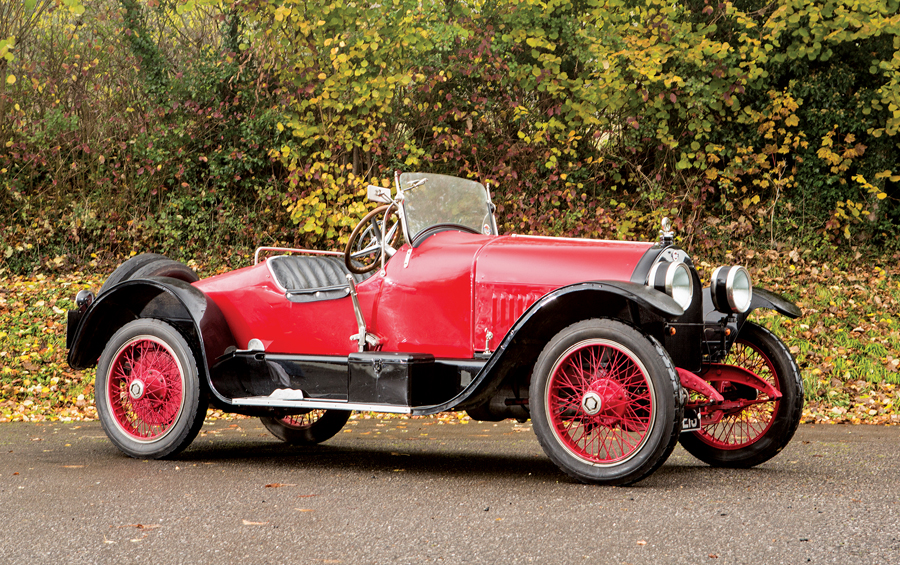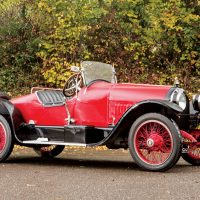Built in just five weeks, Harry Clayton Stutz’s first car did sufficiently well at the 1911 Indianapolis 500, finishing 11th, despite numerous stops for fresh tires, to prompt its creator to set up the Ideal Motor Car Company to manufacture the Stutz.
The first production models were closely based on the successful Indianapolis car and featured proprietary Wisconsin engines and Stutz’s own rear 3-speed transaxle. The Bearcat remained a fixture of the range until the end of the 1924 season, when the installation of Frederick E. Moskovics as company president marked a change of emphasis: From now on, Stutz cars would be aimed at the luxury end of the market.
This car was completed in 1918 at the Stutz factory in Indianapolis, IN, before delivery to the first owner, who is believed by the Stutz Club to be Harry Stutz’s first cousin, Charles Elsworth Stutz. The rare dickey seat and engine-mounting modifications to the crankcase were, reportedly, made after his racing successes with the “Special Bearcat.”
The Stutz comes with a good history file containing sundry restoration invoices, copies of the handbook and technical papers, a V5C document and Stutz Club correspondence. This is a wonderful, powerful, and imposing vintage automobile — and it is ready to use.
SCM Analysis
Detailing
| Vehicle: | 1918 Stutz Bearcat Rumble-Seat Roadster |
| Years Produced: | 1912–24 |
| Number Produced: | 1,564 1918 Stutz Bearcats were built |
| Original List Price: | $2,550 |
| SCM Valuation: | $275,000 |
| Tune Up Cost: | $1,500 |
| Chassis Number Location: | On the right frame rail |
| Engine Number Location: | On case by distributor |
| Club Info: | Antique Automobile Club of America, The Stutz Club |
| Website: | http://www.forums.aaca.org/forum/27-stutz |
| Alternatives: | 1918 Mercer Model 22-73 Raceabout, 1922–25 Bentley 3 Litre, 1922–25 Alfa Romeo RL |
| Investment Grade: | C+ |
This car, Lot 370, sold for $270,220, including buyer’s premium, at Bonhams’ The December Sale in London on December 7, 2016.
“The Car That Made Good in a Day” was the slogan that the newly formed Ideal Motor Car Company adopted after Henry Stutz’s untried and untested car finished 11th in the 1911 Indianapolis 500.
Henry Stayton Stutz, at the age of 35, had an extensive background in the early automotive industry, having worked for U.S. Tire, the Wheeler-Schebler Carburetor Company, the American Motor Car Company and the Marion Motor Car Company. In the middle of all this, in 1910, he designed and patented a transaxle that he sold through the Stutz Auto Parts Company.
Stutz’s dream, however, was manufacturing his own automobile, and he had the insight to recognize a market niche for a quality sports car — similar to the Mercer — that would be priced at about $2,000.
To achieve this objective, Stutz had to get many of the car’s parts from other manufacturers, and this is where his prior background came into play.
In a shop in Indianapolis — with a small crew — he built his first car in just five weeks, and it was destined for the first Indianapolis 500-mile race, which was scheduled for Declaration Day — now known as Memorial Day — in 1911. Entered under the name of the Stutz Auto Parts Company, it remarkably finished the grueling race with nothing more than a few tire changes. It bested proven, more-powerful cars.
Not a win, but good enough to sell cars
The Ideal Motor Car Company began production soon after the Indianapolis 500 race, and the car, the Model A, used the same chassis and engine that ran in the race.
Stutz automobiles enjoyed sales success and continued to be impressive at the racetrack. The 2-passenger speedster was added to the Model A line in 1912 as the Bear Cat, later changed to one word.
The Series S was introduced in 1917, and it had Stutz’s own 16-valve, T-head 4-cylinder engine. The Bearcat was restyled with cut-down sides and a bench seat.
The gear shifter and hand brake were outside the body. The Series S was only offered for two years, as the Series G replaced it in 1919.
An unusual Bearcat
Our subject 1918 Bearcat is unusual in that it is fitted with a dickey, or rumble, seat. It is thought to have been first delivered to Charles Stutz, Henry Stutz’s first cousin. The car’s ownership history is completely known.
It wears an older restoration, as it was last refreshed in the late 1990s.
The Bonhams catalog listed the chassis number as S18333, but the Series S used a range from 1 to 2396, so the correct number is most likely S1833.
The 1918 Stutz Bearcat gained fame as it appeared in an early episode of “Jay Leno’s Garage.” Leno said he had owned it for 20 years, and he spoke glowingly of the car. Leno also said it took 10 years to get his Bearcat properly sorted out. It certainly performed properly on the show.
An approved Classic
The Classic Car Club of America recently expanded their list of Full Classics to include cars manufactured after 1915, which is the beginning of the Classic Era. All Stutz cars, except the HCS, are now accepted, which makes them eligible for CARavans and other activities. This enhances the value of the cars.
Early Stutz Bearcats have sold for well into seven figures, but the later ones don’t seem to have the magic. It has been a number of years since an authentic Series S Bearcat has been offered at public sale, so actual comparables are not readily available. However, Gooding & Company is offering a 1920 Stutz Series H Bearcat at Scottsdale with an estimate of $400k–$500k.
With this car, however, the new owner can proudly state that Jay Leno also has one, and that alone has to be worth the price paid. ♦
(Introductory description courtesy of Bonhams.)





